
Ciudad Real is a municipality of Spain located in the autonomous community of Castile–La Mancha, capital of the province of Ciudad Real. It is the 5th most populated municipality in the region.
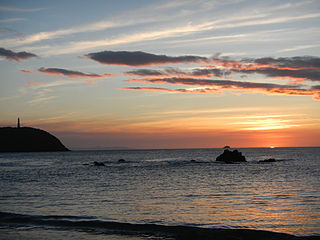
The Nueva Esparta State, is one of the 23 states of Venezuela. It comprises Margarita Island, Coche, and the largely uninhabited Cubagua.

Álamos is a town in Álamos Municipality in the Mexican state of Sonora, in northwestern Mexico.

The verracos, in the Iberian Peninsula, are the Vettones's granite megalithic monuments, sculptures of animals as found in the west of the Iberian meseta – the high central plain of the Iberian peninsula – in the Spanish provinces of Ávila, Salamanca, Segovia, Zamora, Cáceres, Ourense and the Portuguese provinces of Beira Baixa, Beiras e Serra da Estrela, Douro and Terras de Trás-os-Montes. Over 400 verracos have been identified.

Villena is a city in Spain, in the Valencian Community. It is located at the northwest part of Alicante, and borders to the west with Castilla-La Mancha and Murcia, to the north with the province of Valencia and to the east and south with the province of Alicante. It is the capital of the comarca of the Alto Vinalopó. The municipality has an area of 345.6 km² and a population of 34,928 inhabitants as of INE 2008.

Agurain in Basque and Salvatierra in Spanish, it is a town and municipality located in the province of Álava in the Basque Autonomous Community, northern Spain. The municipality, numbering 4,986 inhabitants (2015), is in turn the head town of the district or Cuadrilla of Salvatierra. The gross income per family amounts to 6,784 €. With reference to workforce by economic sectors, 10.36% are employed in agriculture, 35.78% in the industry sector, 47.92% in the service sector and 5.95% in the construction industry.
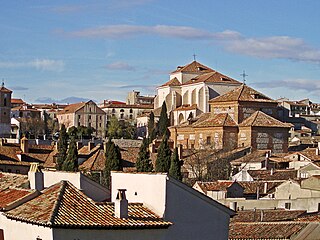
Chinchón is a town and municipality in the Community of Madrid, Spain. Located 50 km south-east of the city of Madrid, the municipality covers an area of 115.91 km2. As of 2018, it has a population of 5,239. Its historic centre, with a notable main square, was declared a Heritage Site in 1974.

Caspe is a municipality in the province of Zaragoza, part of the autonomous community of Aragon (Spain), seat of the comarca Bajo Aragón-Caspe. As of 2018 it had a population of 9,525 inhabitants and its municipality, of 503.33 km², is the fourth largest in Aragon.

Fuente-Álamo is a municipality in Albacete, Castile-La Mancha, Spain. It lies 61 km (37.9 mi) from the provincial capital and had a population of 2,639 as of 2011.

Almagro is a town and municipality situated in Ciudad Real province, in the autonomous community of Castile-La Mancha, Spain. A tourist destination, Almagro is designated a Conjunto histórico, a type of conservation area.

Porzuna is a municipality in Ciudad Real, Castile-La Mancha, Spain located in the Montes region, it occupies an area of 210 km², with an average altitude of 646 meters. It has a population of 3,854
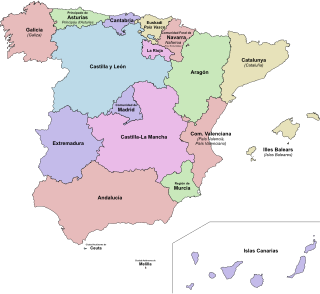
Jérica is a town in the Castellón province of Valencian Community, Spain. It is in the comarca (region) of Alto Palancia. Its population was 1,703 at the end of 2009.

Atajate is a municipality in the province of Málaga in the autonomous community of Andalucia in southern Spain. It is located east of the province in the Genal Valley and is one of the towns that make up the region of the Serrania de Ronda. It is the least populated town in the province of Málaga.
Guadamur is a municipality located in the province of Toledo, Castile-La Mancha, Spain. According to the 2008 census (INE), the municipality has a population of 1819 inhabitants.
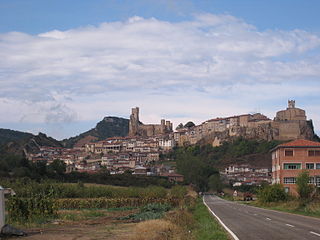
Frías is a town located in the northern part of the province of Burgos, in Castile and León, Spain. In 2010 it had a population of only 275 inhabitants.

Salinas del Manzano is a city of Spain in the province of Cuenca in the autonomous community of Castile-La Mancha. It has an area of 33.65 km2 with population of 105 inhabitants and a population density of 3.21 inhabitants / km2.

Calatrava la Nueva is a medieval castle and convent found on the peak of Alacranejo, within the municipality of Aldea del Rey, near Almagro, in the province of Ciudad Real, Spain.

Sierra Suroeste is a comarca located in southwestern province of Badajoz in the autonomous community of Extremadura, western Spain. Its capital and largest city is Jerez de los Caballeros.
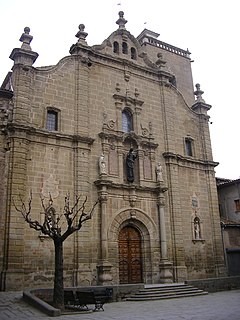
Guissona is a town and municipality located in the North of the comarca (county) of Segarra, in the province of Lleida, Catalonia, Spain. With 6,862 inhabitants Guissona is the principal municipality in the Northern half of Segarra and the second most populated in the county after Cervera. In addition to the populated place of Guissona, the municipality integrates the smaller place of Guarda-si-venes. The municipality is split into two parts, the bigger eastern part containing almost all the population.
30 Coins is a Spanish mystery horror television series created by Álex de la Iglesia for HBO Europe. Directed and written by De la Iglesia and co-written by Jorge Guerricaechevarría, the series follows Father Vergara, an exorcist who is exiled by the church to Pedraza, a remote village in Spain where he hopes he is forgotten by his enemies.




















